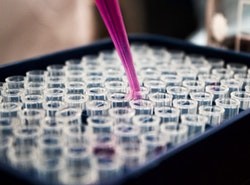
Triple Negative Breast Cancer
While people often speak about breast cancer under one umbrella term, there are different types of cancers. Breast tissue sampled by a biopsy or after surgery is usually sent to a pathologist who will report on several features in the sample, including the status of molecular markers such as the estrogen receptor, progesterone and HER2 (human epithelial growth factor receptor 2). Triple negative breast cancer (TNBC) is a mixed group of tumours that is defined by the absence of all these molecular markers. Accordingly, these breast cancers are negative for estrogen receptors, progesterone receptors and HER2.
What is TNBC?
TNBC accounts for around 10-15% of all breast cancers. TNBC is different to other types of breast cancer as it doesn’t have any of the three receptors usually found on the surface of breast cancer cells: estrogen receptors, progesterone receptors and HER2. As a result, these breast cancers do not respond to treatments targeting these receptors, meaning other treatment options, such as surgery combined with chemotherapy, immunotherapy and other targeted treatments are needed to treat this breast cancer subtype.
Risk Factors for Triple Negative Breast Cancer
TNBC is present disproportionally in some populations more than others. Rates of TNBC are higher among young women (<50 years) and these tumours tend to be more aggressive. Furthermore, for younger patients, the risk is lower for women who have breast-fed for at least a year compared to women who never breast fed.
Mutations in the BRCA1 and BRCA2 gene increases the risk of developing TNBC. Around 5-10% of people with breast cancer have a mutation of their BRCA1 and BRCA2 genes, which, when performing normally, work by repairing the DNA preventing the accumulation of DNA damage which can lead to the formation of tumours.
In terms of prevention, similar risk reducing behaviours for all breast cancers could lower an individual’s risk of developing TNBC such as a healthy diet, exercise and other lifestyle factors such as not smoking and limiting alcohol intake.
How Fast Can Triple Negative Breast Cancer Spread?
TNBC is an aggressive, fast-growing cancer, which is why early detection is so critical for positive long-term outcomes. Speak to your GP or healthcare professional at the first sign of any lumps or changes in your breasts.If you’re between 50 – 74, be sure to attend your free mammogram every two years. Women over 40 years of age can also have a free mammogram every two years.
What Does Triple Negative Breast Cancer Mean in the Long Term?
As with any cancer, TNBC survival rate depends on many factors, including how early it is detected and how it responds to treatment. The prognosis for stage 1 TNBC, for example, is better than the prognosis for stage 3 TNBC, which is what makes early detection and diagnosis so crucial.
Five years after diagnosis, people with TNBC are no more likely to have their cancer come back than those with any other type of breast cancer. And after 10 years, the likelihood of recurrence may in fact be less with TNBC than other breast cancers.
Treatment for Triple Negative Breast Cancer
So, what does TNBC mean in terms of treatment options? While estrogen-, progesterone- and HER2-related breast cancers are often treated with drugs that target these specific receptors, they don’t work for TNBC. However, TNBC does generally respond well to chemotherapy. TNBC therapy may also involve a combination of surgery combined with chemotherapy, radiation, immunotherapy and other targeted treatments.
Hear from Professor Roger Daly on research into new TNBC treatment options
Chemotherapy
Chemotherapy, often called ‘chemo’, is a treatment that uses anti-cancer drugs to kill cancer cells. It may be taken orally or injected intravenously, and the specific drugs used will be determined by the type and stage of cancer. You may experience side effects such as nausea and fatigue, hair loss, constipation and mouth ulcers during treatment.
Lumpectomy
A lumpectomy is a surgical procedure during which the doctor removes the tumour along with some of the surrounding healthy tissue, leaving as much healthy breast tissue as possible.
Mastectomy
This surgical procedure involves the removal of the entire breast and may also include the removal of one or more lymph nodes under the arm. A mastectomy may be required if the cancer is large relative to the size of the breast or if there is more than one cancer present.
Radiotherapy
Also called radiation therapy, this treatment uses targeted radiation to destroy cancer cells or prevent them from growing any further. There may be side effects such as redness or skin peeling in the treatment area, swelling and fatigue.
Triple negative breast cancer (TNBC) is a type of cancer that does not have any estrogen receptors, progesterone receptors and HER2, which are found on the surface of cancer cells in other types of breast cancer.
TNBC is considered to be an aggressive cancer, as it grows quickly. This is particularly true in young women.
This will vary depending on the individual and the stage at which the cancer is detected. However, five years after diagnosis, TNBC is no more likely to recur than other types of breast cancers. Long term (after 10 years), the recurrence of TNBC may be less likely than some other breast cancers.
Related Research
